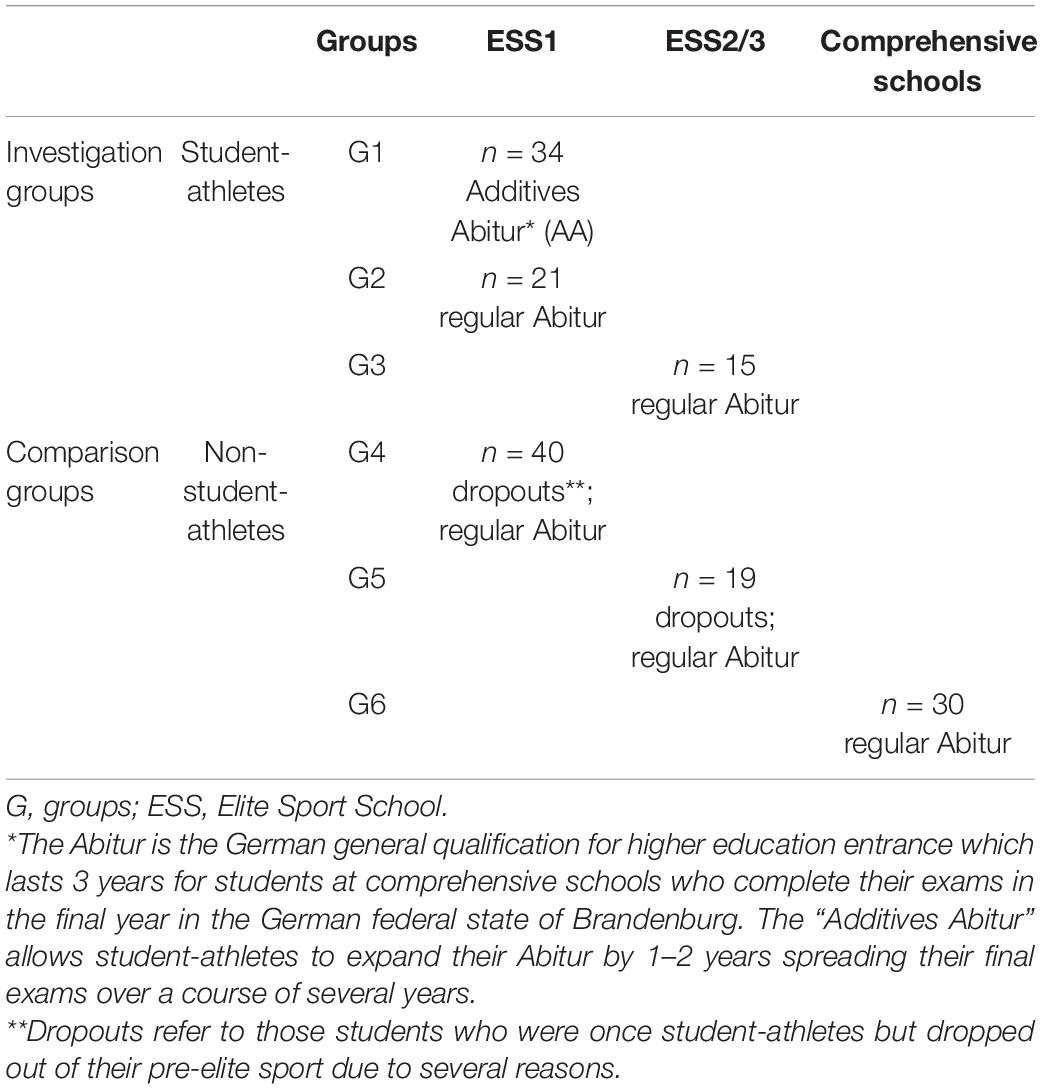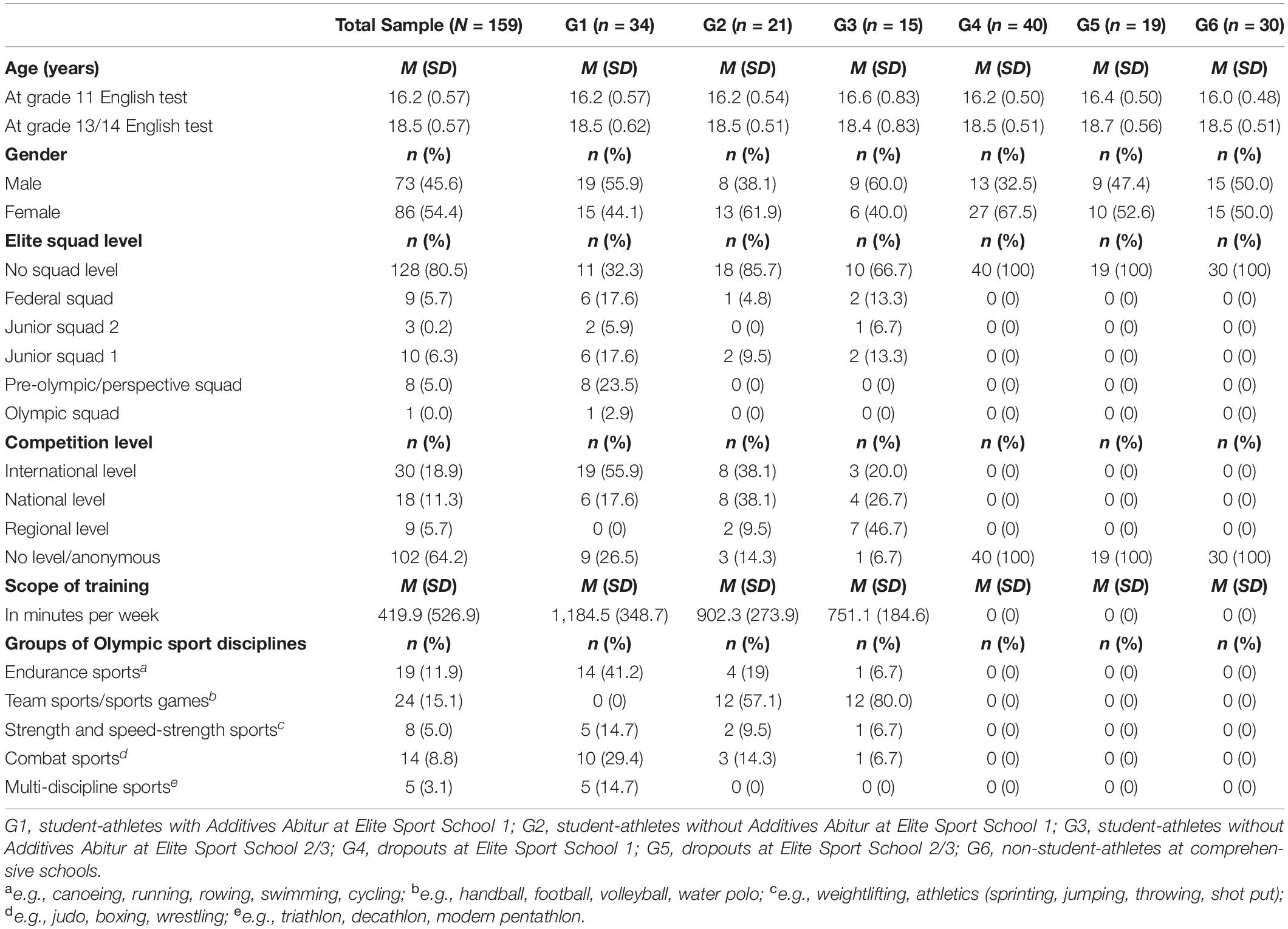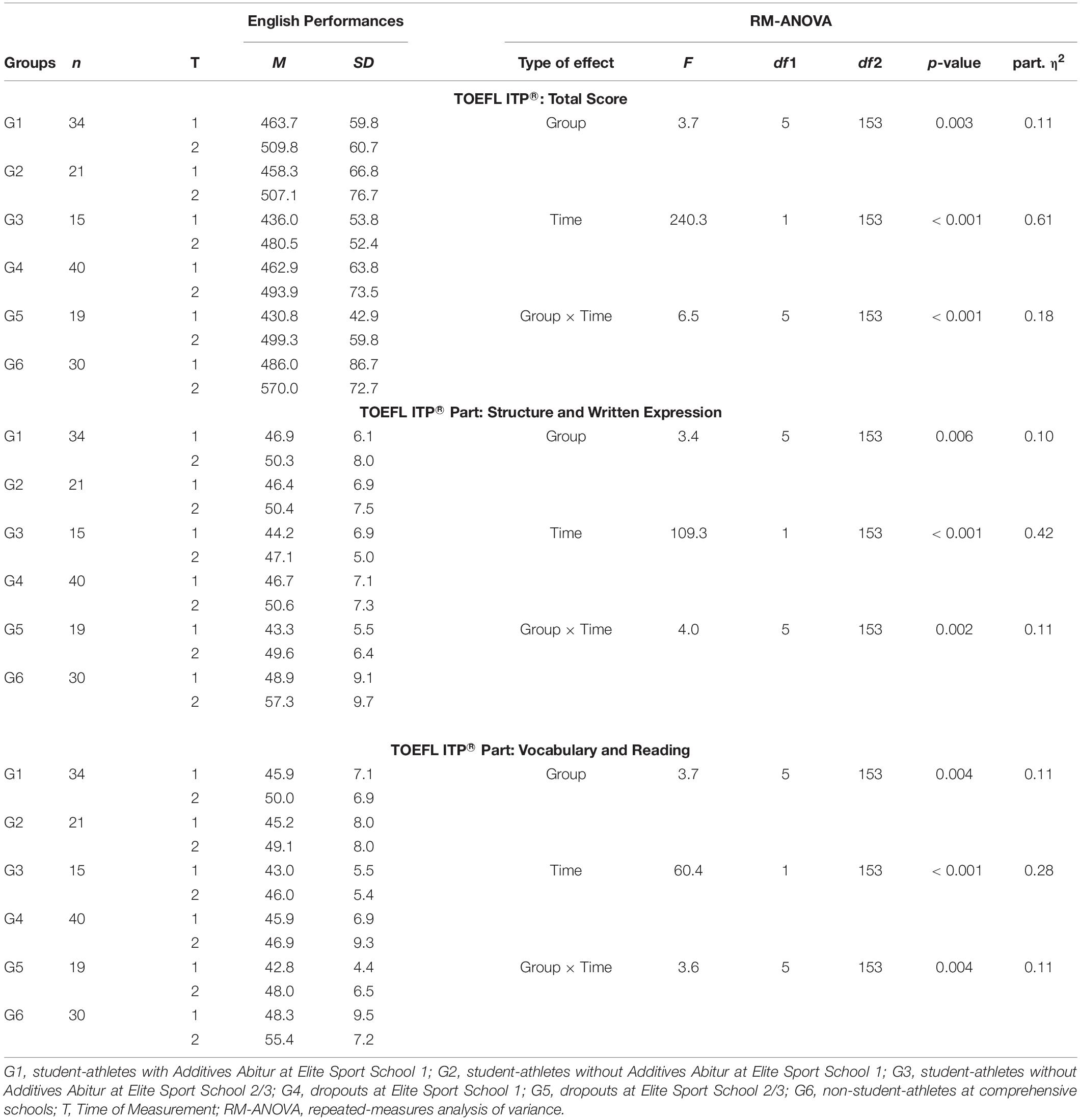- 1Institute of Human Movement Sciences, University of Hamburg, Hamburg, Germany
- 2Educational Sciences and Didactics in PE and Sport, Faculty of Human Sciences, University of Potsdam, Potsdam, Germany
- 3Institute of Sports Science, Saarland University, Saarbrücken, Germany
- 4Educational Research in Sport, Faculty of Sport Science, University of Leipzig, Leipzig, Germany
Studies have evaluated the effectiveness of dual career (DC) support services among student-athletes by examining scholastic performances. These studies investigated self-reported grades student-athletes or focused on career choices student-athletes made after leaving school. Most of these studies examined scholastic performances cross-sectionally among lower secondary school student-athletes or student-athletes in higher education. The present longitudinal field study in a quasi-experimental design aims to evaluate the development of scholastic performances among upper secondary school students aged 16–19 by using standardized scholastic assessments and grade points in the subject English over a course of 3–4 years. A sample of 159 students (54.4% females) at three German Elite Sport Schools (ESS) and three comprehensive schools participated in the study. The sample was split into six groups according to three criteria: (1) students’ athletic engagement, (2) school type attendance, and (3) usage of DC support services in secondary school. Repeated-measurement analyses of variance were conducted in order to evaluate the impact of the three previously mentioned criteria as well as their interaction on the development of scholastic performances. Findings indicated that the development of English performance levels differ among the six groups.
Introduction
Various studies (Borggrefe and Cachay, 2012; Stambulova et al., 2015) as well as the European Commission (2012) identified the difficulty of combining an athletic and academic career simultaneously and being successful in both areas. Coping with tasks in these areas is known as a dual career (DC). Experts are concerned that in a DC academic success suffers from the challenges posed by the athletic career (Creutzburg and Scheid, 2014; Huml et al., 2019). Besides individual opportunity costs, expenses made for an athletic career might result in a less successful academic career (Emrich et al., 2009). The comprehensive review by Thompson et al. (2022) highlights that the research on academic success in a DC is inconclusive. Although student-athletes at sport schools receive considerably more support in academia and athletics, student-athletes suffer from missing school and attaining higher education access (Thompson et al., 2022). This review even identified that there is no positive impact of attending a sport school on academic success. Wylleman and Reints (2010) grasped this holistic approach of understanding DCs with their transition model identifying that athletes transition into several phases on four levels: athletic, psychological, psycho-social, and academic/vocational level. DC support services were introduced to support student-athletes in coping with these personal, academic, and athletic transitions. These DC support services as well as the concept of a student-athlete in a DC differ worldwide (Condello et al., 2019) and across European countries (Morris et al., 2021; Stambulova et al., 2021). The Dual Career Network in Europe currently explores the student-athletes’ perception of DC support services and the need to improve and expand these services for example by introducing the possibility of distance learning and individualizing study plans (Capranica et al., 2022). Besides these institutional support services, other individual and social support structures play a crucial role in assisting student-athletes including parents or coaches (Condello et al., 2019). In Germany, Elite Sport Schools (ESSs) are an example of these institutional support services where training and teaching takes place in the same location reducing time needed for traveling between school and training venues (Emrich et al., 2009; Sallen and Gerlach, 2020). In order to become successful in their athletic careers, German adolescent student-athletes have to cope with their athletic and academic demands simultaneously due to educational policies in Germany. The ESSs help student-athletes to combine both areas with diverse support services by increasing the flexibility of the academic requirements, individualizing the academic career, and improving the compatibility of academia and elite sport. However, the research on effectiveness of these DC support services is scarce (Sallen and Gerlach, 2020).
Although studies outside Europe (Purdy et al., 1982; Alahmed et al., 2016) have evaluated DCs and related support services based on academic performances, these studies were conducted with student-athletes in higher education only. It seems that evaluating academic performances among secondary school student-athletes in order to assess the effectiveness of support services is a European phenomenon, particularly in Belgium, the Netherlands, Denmark, and Germany. Most of these European studies have been implemented with student-athletes in lower secondary school (Borchert, 2013; Wartenberg et al., 2014; Kehne et al., 2018). Only a few studies evaluated academic performances among upper secondary school student-athletes (Brettschneider and Klimek, 1998) and most studies conducted in this age group were run retrospectively (Van Rens et al., 2015; Storm and Eske, 2022).
One study (Hirschmann, 2016) evaluated the successfulness of support services using grades of upper secondary school student-athletes in a cross-sectional approach. Hence, there is no knowledge about the development of upper secondary school student-athletes’ scholastic performances assessed by standardized test instruments.
The performances in the previously mentioned studies were attained on various levels. Some studies have evaluated the effectiveness of the support services based on the career choices student-athletes made after leaving school including vocational training or higher education (Jonker et al., 2009; Van Rens et al., 2015; Storm and Eske, 2022). Others assessed the implementation of support services based on the student-athletes’ grades received in their school report (Wartenberg et al., 2014; Kehne et al., 2018; Storm and Eske, 2022) or the satisfaction with grades (Hirschmann, 2016; Körner et al., 2017). Only self-disclosure on grades, satisfaction with grades, or career path after secondary school were used in order to investigate the effectiveness of support services. Standardized assessments have not yet been applied in this research context.
Findings concerning the academic performance of student-athletes are diverse. Some studies report that ESS student-athletes perform better in academia than their peers at regular schools (Jonker et al., 2009) or at least on the same level (Wartenberg et al., 2014; Kehne et al., 2018; Storm and Eske, 2022). Other studies show contrary results where students at regular schools outperform their peers at ESSs in terms of academic performance (Emrich et al., 2009; Van Rens et al., 2015).
As all grades are self-reported, this reduces the objectivity of school performance evaluations in the previously mentioned studies since grading can be biased (Malouff and Thorsteinsson, 2016). This bias includes irrelevant characteristics for grading such as the students’ ethnic backgrounds, education-related deficiencies, and poor quality of prior performance. Moreover, previous studies have highlighted that grades only correlate moderately with the results of scholastic performance tests (Helmke et al., 2008). Hence, it can be argued that grades are not representative of students’ actual scholastic competence level.
Assessing students’ performances in order to evaluate the success of an educational system or program is the research object of numerous studies such as PISA (OECD, 2019) or DESI (Helmke et al., 2008). In comparison to grades, student performance assessments are more objective and allow a more precise picture of the current competence level. The assessments are supposed to help improve educational systems or programs across the globe. To date, no study has used standardized performance assessments in order to evaluate the effectiveness of support services in ESSs although regular assessments take place on a national level. The assembly of ministers of education of the German federal states have introduced regular assessments of scholastic performances in different grades. One of these assessments is the Abitur. The Abitur is the German general qualification for higher education entrance (e.g. universities) equivalent to the British A-level or United States-American SAT. The Abitur phase lasts 2–3 years for students at comprehensive schools depending on the federal state. In the state of Brandenburg, students at comprehensive schools enter the phase in grade 11 and finish their exams in grade 13. The Abitur allows the teaching staff and the political decision-makers to evaluate the success of their decisions concerning the educational system in each federal state.
In Germany, the subjects German, Mathematics and the First Foreign Language are identified as the three main subjects in all age groups and students taking the Abitur need to complete these subjects. The most prominent choice for the First Foreign Language among German students is English (EACEA, 2012). English is used worldwide as a common language of communication. As Germany is part of the European Union, this language is imperative in order to be able to communicate in European settings. Hence, learning English in school is essential for German students. When learning foreign languages, students generally receive foreign language competencies in four competence areas. Listening and reading are identified as the receptive competence areas, whereas speaking and writing are productive competence areas (Surkamp and Viebrock, 2018).
In a meta-analysis, Hattie (2009) identified several factors the school is responsible for which can help students to improve their learning success. One factor are the support services provided by the school. ESSs are specialized institutions that support student-athletes actively involved in elite sport to be successful in both their academic and athletic career (Emrich et al., 2009; Borggrefe and Cachay, 2014). Students attending these schools have been selected due to their outstanding athletic performances. As these student-athletes have to fulfill the same requirements as non-student-athletes at comprehensive schools in order to obtain their Abitur, ESSs have developed various DC support services. These services vary in each German federal state and the specific ESS ranging from flexible rescheduling of lessons and exams as well as school-free time slots in the morning to extra lessons for German student-athletes attending ESSs. Some DC support services are state specific such as the integration of competitive sport into the school curriculum in the state of Brandenburg whereas other support services such as the “Additives Abitur” (AA) are available to all ESS in the state, but currently used only by one specific ESS in a trial period. The support program AA allows student-athletes to expand their school education in the Abitur phase by one and in some cases by 2 years as well as distributing the final Abitur exams over a course of 3–4 years (Sallen and Gerlach, 2020). The AA is a unique DC support service that has been implemented in 2011 in the German federal state of Brandenburg at the largest of the three ESSs in that state. An overview of the diverse support services in Germany can be found in Figure 1.
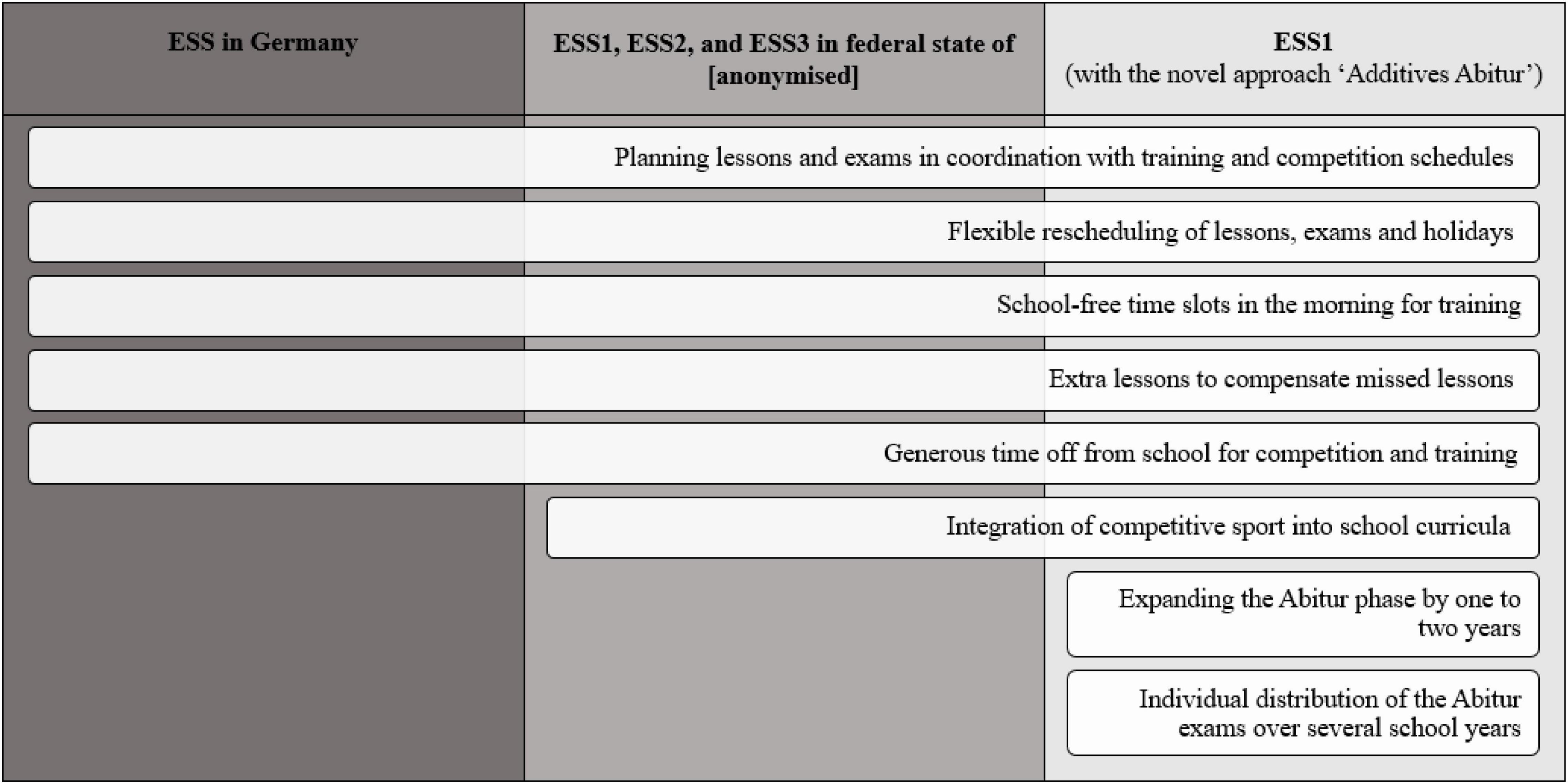
Figure 1. Dual career support services at Elite Sport Schools (ESSs) for student-athletes in Germany, the federal state of Brandenburg, and the ESS1. ESS1, Elite Sport School in the federal state of Brandenburg where the dual career support service “Additives Abitur” was tested.
One of the present study’s aims is to evaluate the effectiveness of this support program. The CIPP model is an internationally used framework for the evaluation of educational institutions and programs (Nevo, 2006) and is in accordance with the quality framework of German educational policies and research activities. The model is an acronym for its four evaluative foci: context, input, process, and product (Stufflebeam, 2003) and is well-known as a model of utilization-of-learning-opportunities in educational research (Seidel, 2014). The present study will focus on product evaluation which identifies the outcomes of the support program (Stufflebeam, 2003) on the basis of a provided structure and input as well as on established processes within a specific DC service system. This evaluative focus assesses the level of success and the effectiveness in reaching the targeted needs of student-athletes.
The Present Study
It has been shown that there is a gap in research regarding the evaluation of the development of scholastic performances among student-athletes since no study so far used a longitudinal design. To our knowledge, no study used standardized performance assessments among upper secondary school student-athletes in order to evaluate their school performances which leads to contrary results regarding the effectiveness of support programs. In order to receive less biased findings, this study is first in using standardized performance assessments in a longitudinal design. In terms of product evaluation (Stufflebeam, 2003) among upper secondary school students, the effect of the following factors and their interactions on the development of scholastic performances will be investigated in order to evaluate the support program AA:
(a) School type (ESS or comprehensive school),
It can be assumed that there is no difference between the development of academic achievements among the different school types. Against the background of the support services provided by the ESS and that these support services are effective, there should be no differences in the development of academic achievements.
(b) Athletic engagement (pre-elite athletes or dropouts/non-athletes), and
Although dropouts do not receive any academic support services, they no longer face athletic constraints and should, hence, be able to focus on their academic success. Therefore, it can be expected that dropouts’ academic achievements develop similarly or even better than those of student-athletes.
(c) Abitur choice (regular or AA).
Since student-athletes taking the AA receive more time in order to achieve academic success, it can be anticipated that these student-athletes’ academic achievements develop better than those of student-athletes taking the regular Abitur.
Materials and Methods
Study Design
By evaluating the outcome of the support program AA, the design of the study is fundamentally oriented toward the CIPP model (Stufflebeam, 2003) focusing on product evaluation. The present investigation is based on a research project which lasted from 2016 to 2021 and evaluated DC support services at ESSs in the German federal state of Brandenburg (Sallen et al., 2019). The underlying longitudinal field study follows a quasi-experimental design. Different groups of students from various schools with different DC support services were accompanied from the beginning to end of their Abitur phase. The students participated in two English tests, one at the beginning of grade 11 and a second test 1–3 months before they completed their Abitur exam in the subject English in either grade 13 or 14. Additionally, the students answered an annual questionnaire.
Measurement Instrument
The English test used in grade 11 assessed the receptive competence area reading in two parts of the English test which is based on an older version of the TOEFL ITP® Level 1 test. The modification has been validated by Trautwein et al. (2010). Part 1 consisted of “Structure and Written Expression” and part 2 of “Vocabulary and Reading.” The English test has been shortened to 35 min and did not include the “Listening” part. The second English test used in grade 13/14 was the TOEFL ITP® Level 1 provided by the Language and Testing Service GmbH (LTS; Berlin, Germany). The TOEFL ITP® Level 1 which lasted 115 min consisted of the same two parts as the English test in grade 11 and this time included “Listening.” Both English tests can be considered as standardized as a standard-setting approach was used (Tannenbaum and Baron, 2011).
In order to identify the language proficiency level according to the Common European Framework of References for Languages (CEFR), the scores in each part of the tests as well as the total score can be used (Tannenbaum and Baron, 2011). The scores and the respective CEFR levels can be found in Table 1. According to Trautwein et al. (2010), students should have reached at least level B1 when starting their Abitur in grade 11. Level B2 or level C1 should be attained when finishing the Abitur depending on the course choice in the subject English (higher or standard level). Reliability of the TOEFL ITP® was given as the test is commonly used in order to assess English competence levels (Tannenbaum and Baron, 2011).
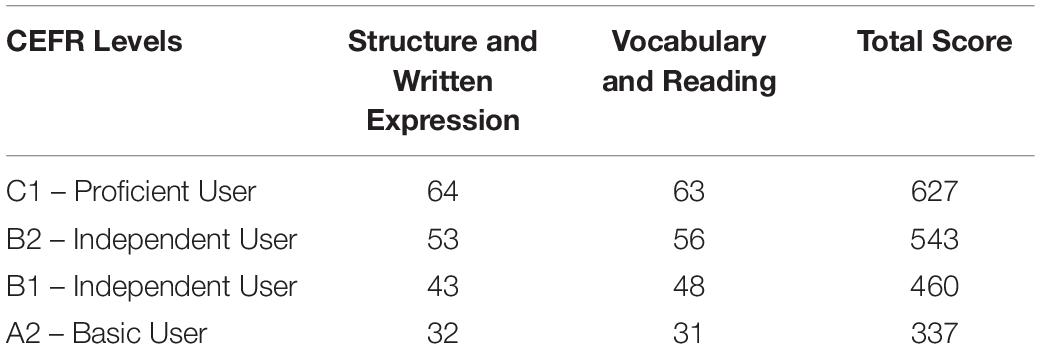
Table 1. Levels of the Common European Framework of References for Languages (CEFR) and the respective score values in the TOEFL ITP® (Tannenbaum and Baron, 2011).
Besides the English tests, students’ English performance levels were measured by the self-reported grades (“What grade did you receive on your last school report in the subject English?”). Moreover, the questionnaire assessed the students’ athletic engagement in terms of athletic performances and achievements (e.g., “Are you active in elite sport?”).
Data Acquisition and Samples
The English tests and the questionnaires were conducted in self-assessment. During the answering of the tests and the questionnaires, student-athletes were guided and supervised in their schools by test coordinators qualified by LTS. The study was approved by the local school authorities and the ethics committee of the University of Potsdam (Potsdam, Germany). All research procedures were in line with the 1964 Helsinki declaration and its later amendments or comparable ethical standards.
A sample of 159 students at three ESSs and three comprehensive schools completed both English tests. All ESSs in the federal state of Brandenburg participated in the study. The ESS1 presents the school where the DC support service AA was provided. The other two ESSs were combined into one group, named ESS2/3, and served as a comparison ESS group to the ESS1. The comprehensive schools were chosen based on the proximity to the institution where the study was prepared. These schools were summed up into one group, named non-student-athletes at comprehensive schools, and served as a comparison group to the ESS groups. For the purpose of the study, the students were divided into six groups. These groups are described in Table 2. The groups have not been selected randomly due to selection mechanisms at the respective schools. Groups 1, 2, and 3 present the investigation groups of this study. All students in these three groups were pre-elite student-athletes with different measures of DC support. Pre-elite student-athletes are young athletes that aspire to become active athletes professionally. Student-athletes in these three groups fulfilled all of the four following criteria concerning active athletes. They (a) train in sports with the aim of improving their athletic performances, (b) participate actively in sport competitions, (c) are formally registered as a competitor at a local, regional, or national sport federation, and (d) have sport training and competition as one of their major activities or focuses of personal interest (Araújo and Scharhag, 2016). Group 1 is the group who completes the AA. This group had a higher athletic engagement in comparison to groups 2 and 3 indicated by a higher squad and competition level as well as a higher scope of training hours per week. In contrast, groups 4, 5, and 6 were the comparison groups. Students in these groups are either dropouts (groups 4 and 5) or were never pre-elite athletes (group 6). Dropouts are students that were once student-athletes but dropped out of pre-elite sports due to several reasons. Detailed sample descriptions on the total sample and the six groups can be found in Table 3.
Data Analysis
Descriptive and variance analysis as well as the data for the English test in grade 11 were analyzed with SPSS Statistics (version 26.0, IBM Corp., Armonk, NY, United States). Results of the English test in grade 13/14 were prepared by LTS and provided to the researchers.
The English test in grade 11 had to be adapted to the same scoring system as the provided results of the grade 13/14 English test in order to be able to compare the results and evaluate the English performance development. The points reached in each of the two parts were transferred into scores similar to the procedure conducted by LTS. In part 1 of the grade 11 English test, students were able to reach a maximum of 23 points which had to be equivalent to 68 score points as identified by Trautwein et al. (2010) who also indicated that 0–5 points equal 31 score points. The remaining points (6–23) were distributed equally over the score of 32–68 points were 23 points in the test equal 68 score points. The same procedure of calculating score points was used for the second part of the grade 11 English test, but this time a total of 28 points could be reached which had to be equal to 67 score points (Trautwein et al., 2010). For the total score, both parts of the grade 11 English test presented the same percentage. The calculation was conducted as follows in order to be able to compare the total score of the grade 11 and grade 13/14 English test (Trautwein et al., 2010).
Since the competence areas Structure and Written Expression and Vocabulary and Reading were tested in both English tests, the development of these parts as well as the development of the total score can be compared.
In a pre-analysis, a Pearson’s correlation was conducted using the self-reported English grade points in grade 11 and 13/14 as well as the scores of Listening, Structure and Written Expression, Vocabulary and Reading, and total scores in the English tests. A positive correlation between grade points and test results was expected since German grade points in upper secondary school are given from 0 (insufficient) to 15 (very good).
In the main analysis, repeated-measures analysis of variance (RM-ANOVA) was conducted with the six groups for Structure and Written Expression, Vocabulary and Reading, the total score, and the grade points in order to evaluate the development of all groups’ English performances in the Abitur phase indicating overall different developments among the groups. In order to evaluate the significant findings of the overall analysis concerning the development of students’ performances, post hoc two-group RM-ANOVAS were conducted in three further steps in consideration of the following characteristics: pre-elite student-athletes vs. dropouts, non-student-athletes vs. ESS students, and student-athletes with AA vs. student-athletes without AA. All four analytical steps are described in detail in Figure 2.
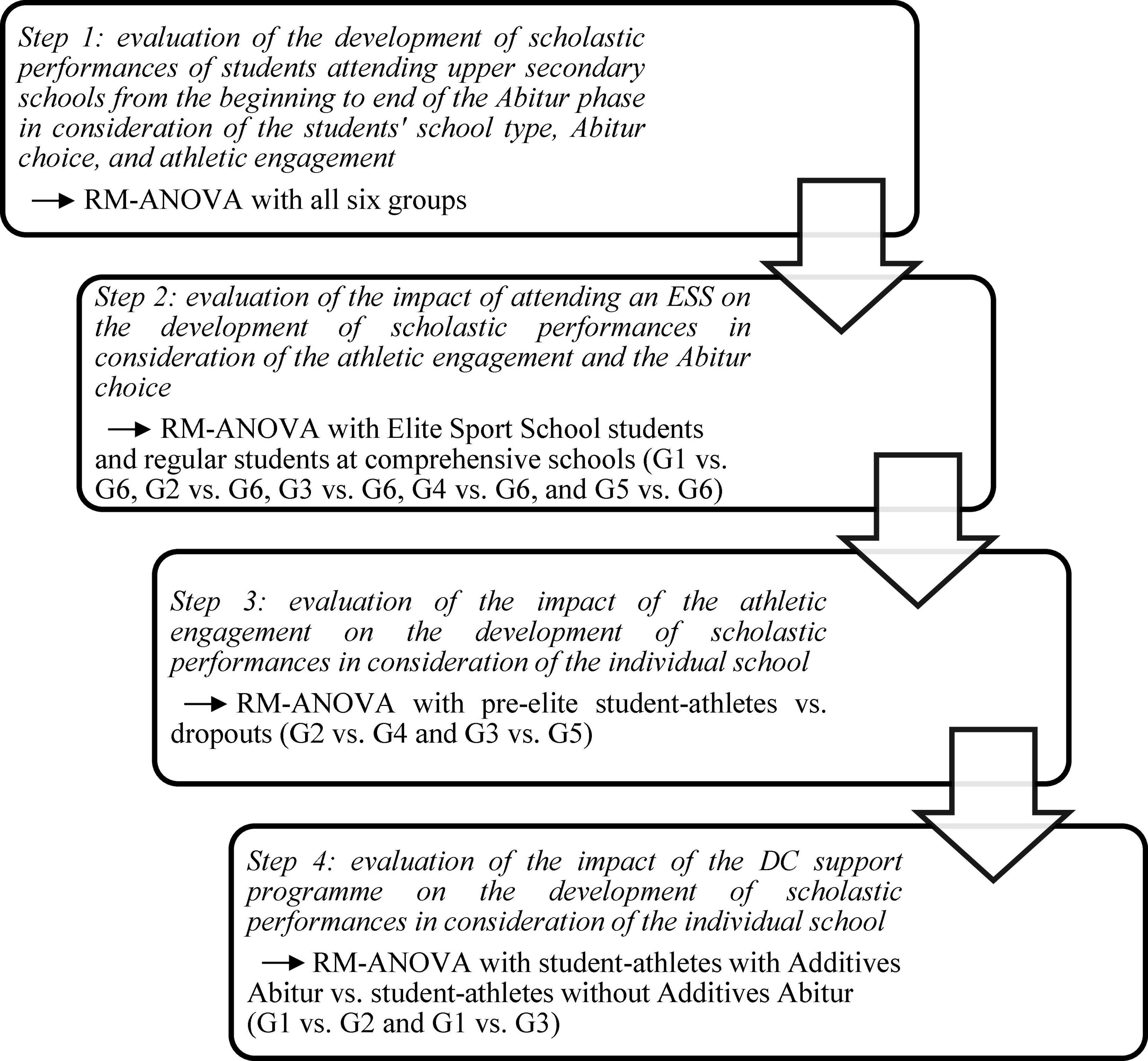
Figure 2. Steps conducted in the data analysis. RM-ANOVA, repeated-measures analysis of variance; G1, student-athletes with Additives Abitur at Elite Sport School 1; G2, student-athletes without Additives Abitur at Elite Sport School 1; G3, student-athletes without Additives Abitur at Elite Sport School 2/3; G4, dropouts at Elite Sport School 1; G5, dropouts at Elite Sport School 2/3; G6, non-student-athletes at comprehensive schools.
A cut point of p ≤ 0.05 was used in order to identify significant effects. Due to the exploratory nature of the study and in line with (Cohen, 1988), the effect size η2 was interpreted as small (0.01 ≤η2 ≤ 0.06), medium (0.6 <η2 ≤ 0.14), and large (η2 ≥ 0.14).
Results
Pre-analysis
Contrary to previous findings (Helmke et al., 2008), the results of the correlation indicate a strong positive correlation between the Structure and Written Expression, Vocabulary and Reading, and the total score of the grade 11 English test with the grade points in grade 11, r = 0.52, r = 0.60, and r = 0.62 respectively (ps < 0.001). In addition, a strong positive correlation was found for Listening, Structure and Written Expression, Vocabulary and Reading, and the total score in the grade 13/14 English test when correlated with the grade points in grade 13/14, r = 0.56, r = 0.66, r = 0.61, and r = 0.65 respectively (ps < 0.001).
Main Analysis
The descriptive results can be found in Table 4 as well as Figures 3–5. All results concerning the evaluation of the grade points and the results of the post hoc two-group RM-ANOVAs can be found in the electronic supplement. All tables and figures in the supplements are marked by an Supplementary before the respective number.
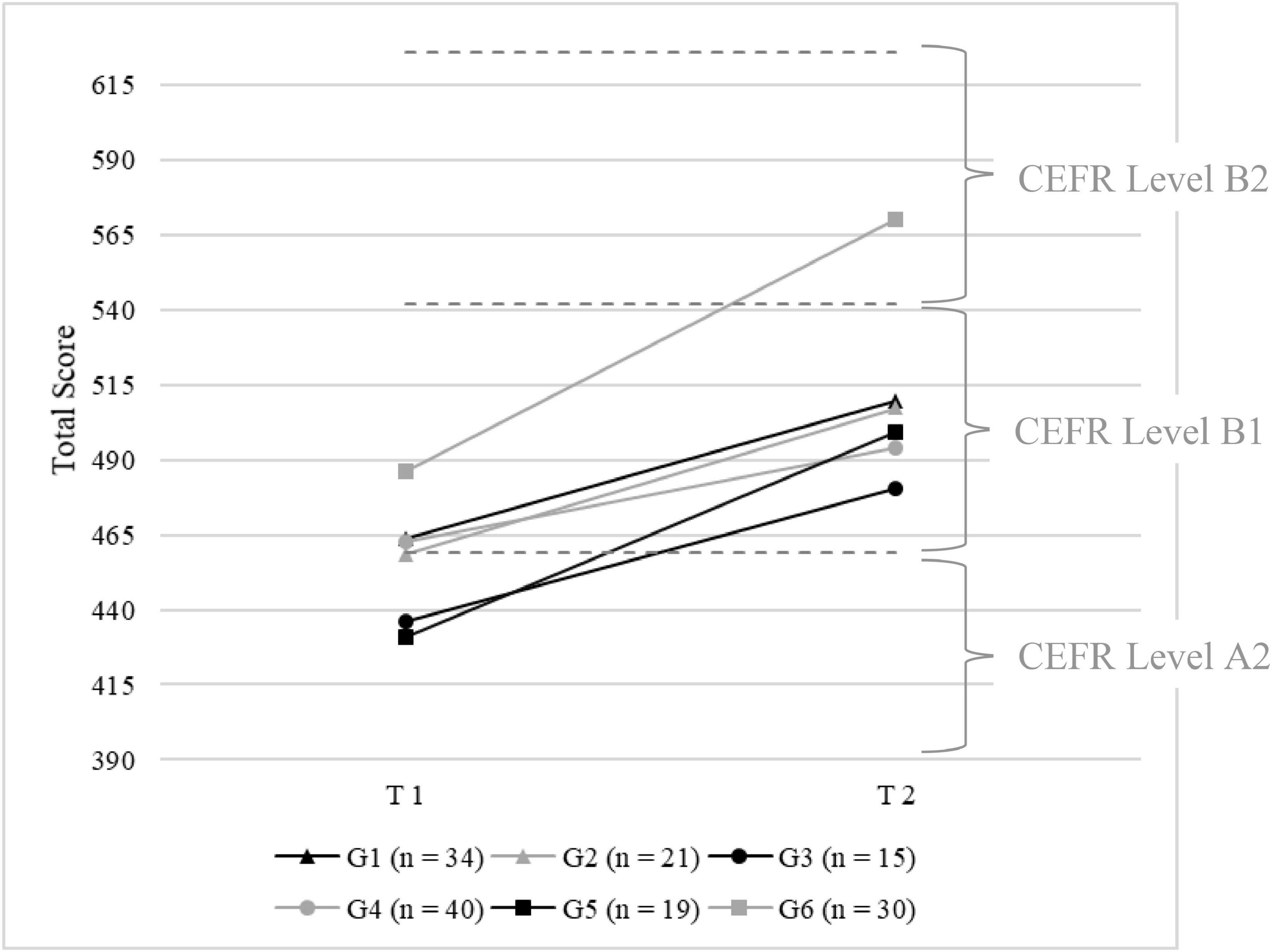
Figure 3. Development of the English skills in terms of the total score (from 310 = worst result to 677 = best result). T, Time of Measurement; G1, student-athletes with Additives Abitur at Elite Sport School 1; G2, student-athletes without Additives Abitur at Elite Sport School 1; G3, student-athletes without Additives Abitur at Elite Sport School 2/3; G4, dropouts at Elite Sport School 1; G5, dropouts at Elite Sport School 2/3; G6, non-student-athletes at comprehensive schools; CEFR, Common European Framework of References for Languages.
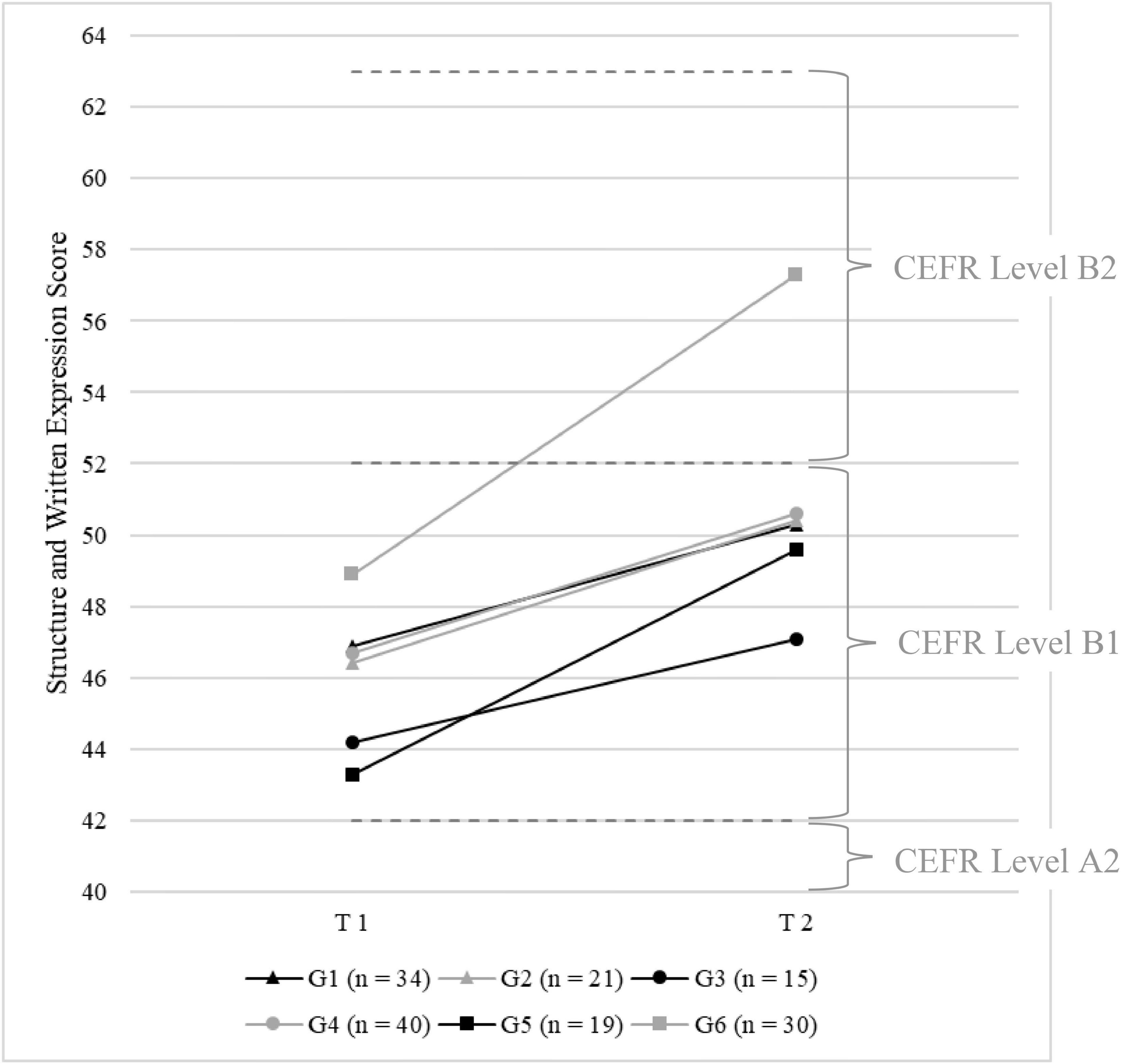
Figure 4. Development of the English skills in the competence area “Structure and Written Expression” (from 31 = worst result to 68 = best result). T, Time of Measurement; G1, student-athletes with Additives Abitur at Elite Sport School 1; G2, student-athletes without Additives Abitur at Elite Sport School 1; G3, student-athletes without Additives Abitur at Elite Sport School 2/3; G4, dropouts at Elite Sport School 1; G5, dropouts at Elite Sport School 2/3; G6, non-student-athletes at comprehensive schools; CEFR, Common European Framework of References for Languages.
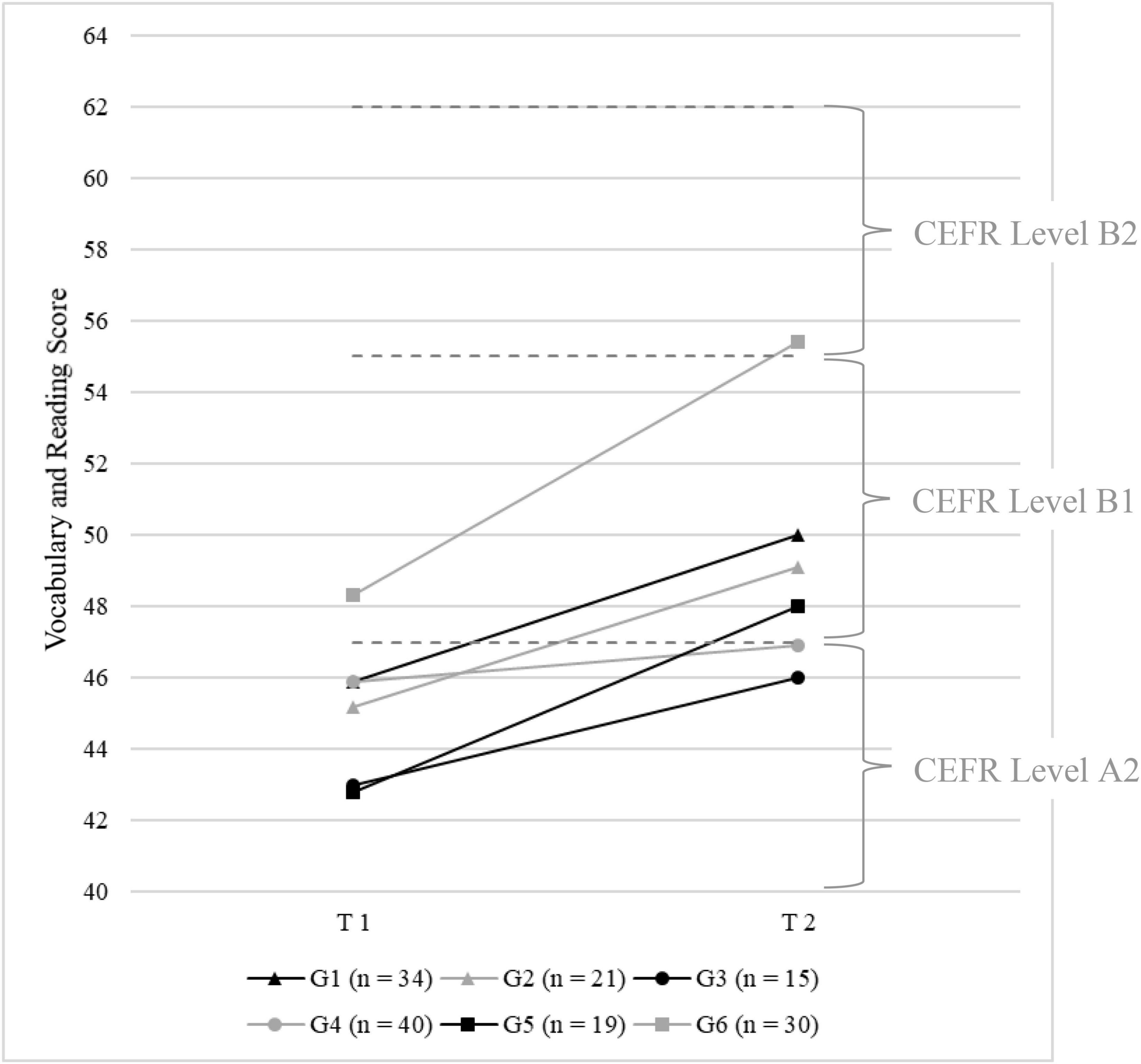
Figure 5. Development of the English skills in the competence area “Vocabulary and Reading” (from 31 = worst result to 67 = best result). T, Time of Measurement; G1, student-athletes with Additives Abitur at Elite Sport School 1; G2, student-athletes without Additives Abitur at Elite Sport School 1; G3, student-athletes without Additives Abitur at Elite Sport School 2/3; G4, dropouts at Elite Sport School 1; G5, dropouts at Elite Sport School 2/3; G6, non-student-athletes at comprehensive schools; CEFR, Common European Framework of References for Languages.
Step 1: The findings indicate a different development of English test results between the six groups for Structure and Written Expression, Vocabulary and Reading, and the total score as well as the grade points (Table 4, Supplementary Table 1, Figures 3–5, and Supplementary Figure 1). English performances in Structure and Written Expression developed better than in Vocabulary and Reading for all groups.
Step 2: The impact of ESS attendance on the development of English performances was evaluated in consideration of the athletic engagement and Abitur choice by comparing the ESS groups to the comprehensive school group individually (Table 5 and Supplementary Tables 2–6). Contrary to the initial expectation, the findings indicate that students attending an ESS (groups 1–5) achieved worse test results over time for Structure and Written Expression, Vocabulary and Reading, and the total score than non-student-athletes at comprehensive schools (group 6). Moreover, the development of the English test results was better for non-student-athletes since all results showed a significant difference and a high η2 in terms of the interaction effect compared to ESS students. Dropouts attending the ESS2/3 (group 5) present an exception to this trend. Nevertheless, their English test results remained below those of non-student-athletes. The developmental results of the grade points did not differ between ESS and non-student-athletes apart for the grade point development between student-athletes at ESS2/3 (group 3) and non-student-athletes with a better development for the non-student-athletes.
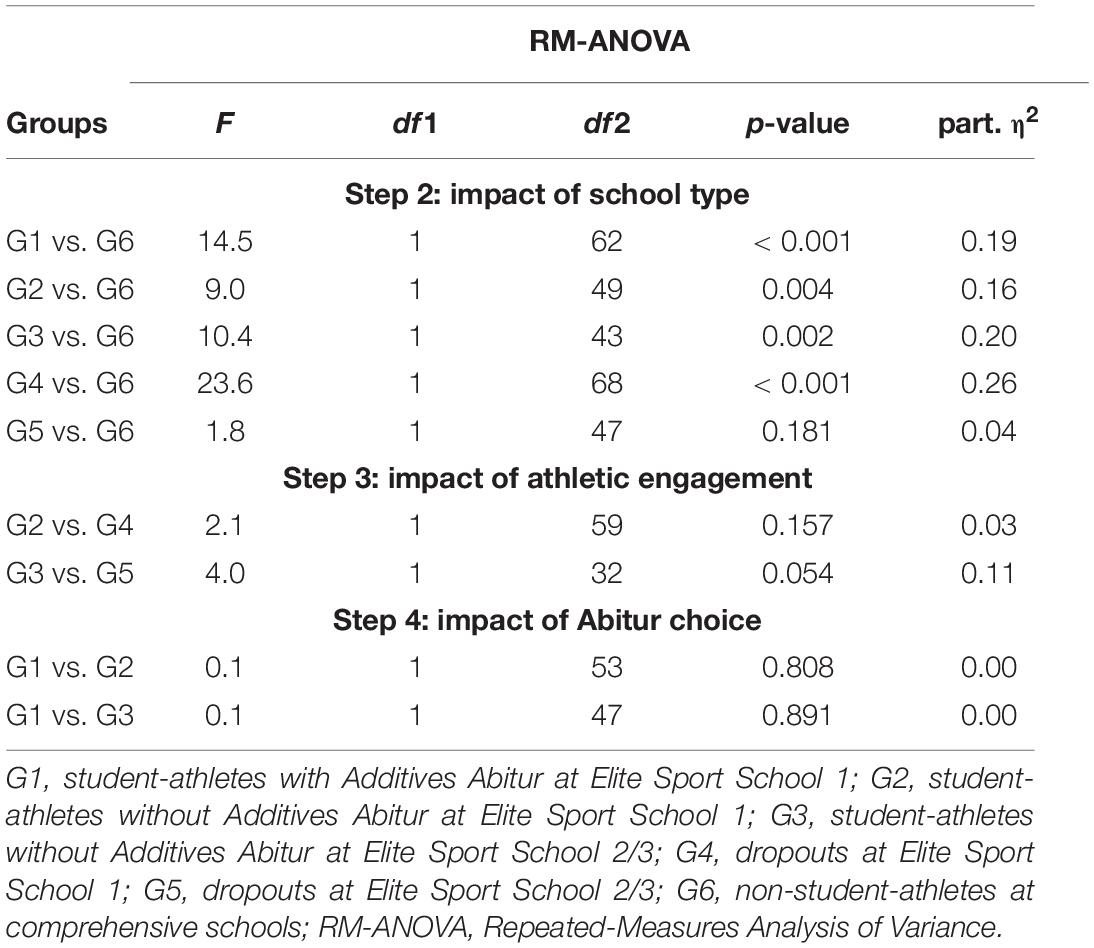
Table 5. Extract of Supplementary Tables 2–10 in the electronic supplements presenting the post hoc two group interaction effects (Group × Time) of the RM-ANOVAs for the total score in the English tests.
Step 3: The impact of athletic engagement was evaluated in consideration of the individual school by comparing group 2 to group 4 and group 3 to group 5 (Table 5 and Supplementary Tables 7, 8). In line with the initial assumption, there was no statistically significant interaction effect for the development of English test results or grade points of student-athletes without AA (groups 2 and 3) and dropouts at the ESSs (groups 4 and 5). However, when comparing the individual schools, there were contrary findings in the English test results demonstrated by the high effect sizes. At the ESS1, English test results developed better for the student-athletes without AA (group 2) than for the dropouts (group 4). In contrast, students’ test results at ESS2/3 developed better for dropouts (group 5) than for the student-athletes (group 3).
Step 4: In terms of evaluating the product of the DC support service AA as per CIPP model (Stufflebeam, 2003), the impact of the support service on English performance development was investigated by comparing groups 2 and 3 to group 1 individually (Table 5 and Supplementary Tables 9, 10). The findings did not meet the initial assumptions as they indicate that there was no significantly different development of English test results between student-athletes with and without AA. Nevertheless, student-athletes with AA (group 1) performed better in the English test than student-athletes without AA (groups 2 and 3) in grade 11 and 13/14 (Figures 3–5). In terms of the grade points, student-athletes at ESS1 (group 1 and 2) showed a similar development of grade points. However, student-athletes’ grade points at ESS2/3 (group 3) developed significantly worse than student-athletes’ with AA.
Discussion
The present study investigated the development of English performances of German students at ESSs and comprehensive schools by using standardized scholastic assessments in the subject English for the first time. In order to assess the outcome and effectiveness of the support program AA, the study focused on the product evaluation of the CIPP model (Stufflebeam, 2003). The study found that there is a significantly different development of academic achievements between the ESS groups and the comprehensive school group.
Although one could argue that the academic progress student-athletes make each year can be a stronger measure than comparing their academic achievements to those of non-student-athletes and that DC support services can only be evaluated when considering the academic as well as the athletic achievements, this study primarily aims to evaluate the DC support service AA. Hence, a comparison of academic achievements between athletically active and inactive students is necessary, but also because non-student-athletes cannot provide athletic achievements which can then not be compared to the student-athletes’ athletic achievements. Nevertheless, the evaluation of the annual academic progress of student-athletes as well as their athletic achievements and athletic progress should be investigated in further studies.
First, the development of the students’ scholastic performances in the subject English was examined with regards to the school type, athletic engagement, and Abitur choice. These characteristics seem to have an impact on the development of students’ scholastic performances. Although all groups achieved better test results in the second than in the first English test, it is striking that the total scores of all ESS groups in grade 13/14 stayed below the recommendations by Trautwein et al. (2010) concerning the CEFR level B2/C1.
In a second step, the impact of attending an ESS on the scholastic performances was investigated in consideration of the Abitur choice and athletic engagement. The findings were not in line with the initial assumption and contrary to the study by Jonker et al. (2009) as non-student-athletes’ English test results develop better than ESS students’. Jonker et al. (2009) found that student-athletes attended pre-university classes and university more often than non-athletes indicating higher overall school performances for student-athletes. This contrary finding can be explained by the assessment of school performances. Jonker et al. (2009) assessed the performance based on career choices whereas the present study used scholastic tests and grade points. The findings of the present study are, however, in line with the findings by Thompson et al. (2022) who found that attending a sport school does not have a positive effect on academic success. Two reasons can be identified for the previously mentioned difference in the development of ESS students vs. non-student-athletes in the present study. On the one hand, ESS students have less time and energy in order to fulfill demands of both the athletic and academic career (Emrich et al., 2009; Thompson et al., 2022) even before they enter the Abitur phase, thus, leading to generally worse developments of school performances. On the other hand, ESSs do not and/or cannot provide the same level of education to their students as comprehensive schools due to their dual mission of achieving successful results in the academic and athletic area, a reduced sense of entitlement toward ESS students, as well as other imposed educational policies. Hence, future studies should explore the general conditions ESS can provide for student-athletes and how these conditions can be improved in order to provide optimal DC support for student-athletes.
Thirdly, the impact of athletic engagement on the development of the scholastic performances was examined in consideration of the individual school. The statistically non-significant results are in line with the initial assumptions as well as previous findings by Wartenberg et al. (2014) and Kehne et al. (2018) who indicated that school performances are similar for student-athletes and non-athletes. However, the high effect sizes indicate that in terms of the athletic engagement the individual school has an impact on the English test results since at ESS2/3 dropouts’ performances develop better than student-athletes and for ESS1 the contrary is the case. Unfortunately, there is no logical explanation for this finding. It seems that pre-elite athletic engagement can have an impact on the development of scholastic performances depending on the individual school with its teachers, coaches and local framing conditions. Moreover, individual support systems like parents or friends can have an impact on the academic development of student-athletes and dropouts (Condello et al., 2019). Thus, policy makers should investigate the general conditions at each ESS and aim to compare the effectiveness of each ESS on the DC development of student-athletes.
In the final analytical step, the impact and outcome of the DC support service AA was evaluated following the CIPP model (Stufflebeam, 2003). Contrary to the initial assumptions, the findings indicated that the support service AA does not have a remarkable impact on the development of English test results. Nevertheless, the mean scores in all parts and the total score are always higher for student-athletes with AA than for student-athletes without AA which indicates a small selection effect at the entrance of the Abitur phase. At the same time, student-athletes with AA demonstrated a higher athletic engagement as emphasized by their higher squad level, higher competition level, as well as a higher scope of training hours per week. In addition, all student-athletes with AA were athletes in individual sports (e.g., judo, athletics, etc.) who reach their peak performance earlier in their athletic career than team sport athletes (Longo et al., 2016). Consequently, it could be argued that the support service AA allows student-athletes to achieve academic results similar to those of their peers at ESSs although they are confronted with higher demands posed by their athletic career. Hence, the support service AA seems to be successful as it can absorb some of the additional demands posed by the DC (Sallen and Gerlach, 2020). As a result, athletic demands interfered less with academic tasks (Storm and Eske, 2022). Additionally, the support service in the present study allowed student-athletes with AA to receive more similar results to their peers at comprehensive schools which has previously been defined as problematic (Thompson et al., 2022). However, the support service AA seems to be selective as it only allows athletes in individual sports to participate. This selection mechanism might be due to the fact that athletes in team sports have less flexibility to change and deviate from training intensity and hours than those in individual sports. Hence, the selective mechanism of the AA should be investigated in further studies. Emrich et al. (2009) as well as Storm and Eske (2022) identified further successful support services and DC programs which aid students in combining their athletic and academic careers. It would be interesting to evaluate whether the concrete usage of these diverse support services and the ones identified in Figure 1 have an impact on the development of scholastic performances of pre-elite student-athletes (Sallen and Gerlach, 2020).
Finally, the results concerning the grade points need to be discussed. Interestingly, non-student-athletes at comprehensive schools achieve only a medium grade point average in comparison to ESS students although their results in the English tests are significantly better. This contradiction highlights that in order to receive a realistic picture of the students’ competence levels scholastic performance assessments need to be evaluated as grades are not a reliable indicator of actual competence levels. Moreover, policy makers should take note that grading in schools should be treated with more caution in order to offer fair and equal opportunities to all students independent of their school type (ESS vs. comprehensive schools) and athletic engagement.
Strength of the present study can be found in the unique and novel study design. The quasi-experimental design with six differentiated groups facilitates a greater insight into the contexts and developments of student-athletes’ scholastic performances. Furthermore, the study is the first one to evaluate the scholastic performances longitudinally and prospectively among pre-elite upper secondary school student-athletes using standardized school performance tests. This study design allows a new perspective on the academic developments of pre-elite student-athletes as this form of assessment prevents biases. Although the study’s sample size seems small at first, the overall sample of student-athletes is restricted due to its elite nature. Keeping the elite context in mind, the sample size is in fact quite large.
Besides these strengths, limitations of the present study should be considered. On the one hand, “Listening” was absent in the first English test and the total score was calculated without this part. This total score calculation might lead to a slight deviation when comparing the total score of the first English test to the second. On the other hand, both tests assessed receptive competence areas only. As the foreign language competencies consist of the receptive and productive competence area, the study limits the assessment of the foreign language competence to one competence area. Moreover, some variables could not be controlled for due to the naturally small sample size of student-athletes. This absent control might lead to a distortion of the results. Lastly, this study focuses on the product evaluation of the CIPP model (Stufflebeam, 2003) and takes the other three evaluation foci for granted. Consequently, other studies should focus on more than output aspects in terms of the CIPP model by analyzing diverse aspects in evaluating scholastic competences including subjective satisfaction, perceived stress levels, engagement in sport, or personality indicators in order to obtain a holistic picture of the effectiveness of DC services such as the AA.
Conclusion
In conclusion, the present study is the first one which evaluates the development of scholastic performances among student-athletes in upper secondary schools using standardized scholastic tests and grade points simultaneously against the background of the CIPP model (Stufflebeam, 2003). The findings highlight that besides grade points the results of standardized tests need to be considered when evaluating scholastic performances at ESSs as the grade points are not fully congruent with the test results. Moreover, findings of the present study indicate that the present DC support program AA is unable in supporting student-athletes to reach similar academic successes in the subject English as non-student-athletes at comprehensive schools. This shortness highlights that student-athletes need further support in their academic careers as their athletic demands interfere with the development of their scholastic performances. However, the study also indicates that the student-athletes with AA achieve more similar academic performances to non-student-athletes than student-athletes without AA even though they invest more time in their sport. Hence, further DC support services need to be developed and scientifically evaluated in order to offer similar academic opportunities to student-athletes as their peers at comprehensive schools by increasing the flexibility of academic requirements, individualizing the academic career, and improving the compatibility of academia and elite sport. Further research on DC support services could, for example, focus on evaluating the academic and athletic achievements as well as stress perception and well-being of student-athletes simultaneously or by investigating the differences in the usefulness of the services. Furthermore, future studies should focus on different developments among athletes in team vs. individual sports.
Data Availability Statement
The datasets presented in this article are not readily available because the dataset is restricted due to sensitive data. Requests to access the dataset should be directed to the authors.
Ethics Statement
The studies involving human participants were reviewed and approved by the University of Potsdam and the Ministry of Education, Youth and Sport of the Federal State of Brandenburg (Germany). Written informed consent to participate in this study was provided by the participants or their legal guardian/next of kin.
Author Contributions
JS, EG, and TW were the principal investigators of the third party research project were the data stem from. JS and EG were mainly responsible for the overall conception and design of this study. MN took lead in the conception of the manuscript, the statistical analysis, and in writing the manuscript. JS organized the study samples and led the data acquisition. MN, JS, and EG made substantial contributions to the analysis and interpretation of data. All authors developed, revised, and approved the manuscript to be published.
Funding
This work was jointly supported by the German Ministry Federal Institute of Sport Science (grant number 071102/16-21) and the Ministry of Education, Youth and Sport of the Federal State of Brandenburg (Germany).
Conflict of Interest
The authors declare that the research was conducted in the absence of any commercial or financial relationships that could be construed as a potential conflict of interest.
Publisher’s Note
All claims expressed in this article are solely those of the authors and do not necessarily represent those of their affiliated organizations, or those of the publisher, the editors and the reviewers. Any product that may be evaluated in this article, or claim that may be made by its manufacturer, is not guaranteed or endorsed by the publisher.
Acknowledgments
We would like to thank Lucas Schole (Institute of Human Movement Sciences, University of Hamburg, Hamburg, Germany) for his support in collecting and preparing the data for the in-depth analysis. We would also like to express our thanks to Language and Testing Service (Ltd.) for providing comparative data of the Go4Goal! English language competition. We would also further like to thank Ulrich Trautwein and his working group for providing the grade 11 English test.
Supplementary Material
The Supplementary Material for this article can be found online at: https://www.frontiersin.org/articles/10.3389/feduc.2022.946284/full#supplementary-material
References
Alahmed, M., Yusof, A., and Shah, P. (2016). Attitude, sports participation and academic performance of undergraduate student-athletes in Saudi-Arabia. J. Phys. Educ. Sport 16, 1000–1004.
Araújo, C. G. S., and Scharhag, J. (2016). Athlete: a working definition for medical and health sciences research. Scand. J. Med. Sci. Sports 26, 4–7. doi: 10.1111/sms.12632
Borchert, T. (2013). Ohne Doppelten Boden Aber Mit Netz? Förderung Sportlicher Begabung und Soziale Unterstützung an Eliteschulen des Sports in Brandenburg [Promotion of Athletic Talent and Social Support at Elite Sport Schools in Brandenburg]. Chemnitz: Universitätsverlag Chemnitz.
Borggrefe, C., and Cachay, K. (2012). “Dual careers”: the structural coupling of elite sport and school exemplified by the German Verbundsysteme. Eur. J. Sport Soc. 9, 57–80. doi: 10.1080/16138171.2012.11687889
Borggrefe, C., and Cachay, K. (2014). Spezialschulen Sport in Brandenburg – ein Modell für Deutschland? [Special sport school in Brandenburg – a model for Germany?]. Leistungssport 44, 40–46.
Brettschneider, W.-D., and Klimek, G. (1998). Sportbetonte Schulen. Ein Königsweg zur Förderung sportlicher Talente? [Schools with a Sporting Emphasis. An Ideal Solution to Promote Athletic Talent?] Aachen: Meyer & Meyer Verlag.
Capranica, L., Doupona, M., Abelkalns, I., Bisenieks, U., Sánchez-Pato, A., Cánovas-Alvarez, F. J., et al. (2022). Understanding dual career views of European university athletes: the more than gold project focus group. PLoS One 17:e0264175. doi: 10.1371/journal.pone.0264175
Condello, G., Capranica, L., Doupona, M., Varga, K., and Burk, V. (2019). Dual-career through the elite university student-athletes’ lenses: the international FISU-EAS survey. PLoS One 14:e0223278. doi: 10.1371/journal.pone.0223278
Creutzburg, S., and Scheid, V. (2014). Qualitätsentwicklung an Partnerschulen des Leistungssports. Evaluationsstudie zum Landesprogramm Talentsuche – Talentförderung in Hessen [Quality Development at Partner Schools of Elite Sport. Evaluation Study of the Federal State Programme “Talent Searching – Talent Promotion” in Hesse]. Schorndorf: Hofmann.
Emrich, E., Fröhlich, M., Klein, M., and Pitsch, W. (2009). Evaluation of the elite schools of sport. Empirical findings from an individual and collective point of view. Int. Rev. Sociol. Sport 44, 151–171. doi: 10.1177/1012690209104797
European Commission (2012). EU Guidelines on Dual Careers of Athletes: Recommended Policy Actions in Support of Dual Careers in High-Performance Sport: Approved by the EU Expert Group ‘Education & Training in Sport’ at its meeting in Poznań on 28 September 2012. Brussels: European Commission.
Hattie, J. (2009). Visible Learning. A Synthesis of Over 800 Meta-Analyses Relating to Achievement. London: Routledge.
Helmke, A., Schrader, F.-W., Wagner, W., Nold, G., and Schröder, K. (2008). “Selbstkonzept, Motivation und Englischleistung [self-concept, motivation, and English performance],” in Unterricht und Kompetenzerwerb in Deutsch und Englisch. Ergebnisse der DESI-Studie, ed. E. Klieme (Weinheim: Beltz), 244–257.
Hirschmann, F. (2016). Chronischer Stress im Nachwuchsleistungssport. Eine empirische Studie an bayerischen Eliteschulen des Sports [Chronic Stress in Junior Elite Sports. An empirical study at Bavarian Elite Sport Schools]. Passau: Universität Passau.
Huml, M. R., Bergman, M. J., Newell, E. M., and Hancock, M. G. (2019). From the playing field to the classroom: the academic challenges for NCAA division I athletes. J. Study Sports Athletes Educ. 13, 97–115. doi: 10.1080/19357397.2019.1578609
Jonker, L., Elferink-Gemser, M. T., and Visscher, C. (2009). Talented athletes and academic achievements: a comparison over 14 years. High Ability Stud. 20, 55–64. doi: 10.1080/13598130902863691
Kehne, M., Breithecker, J., and Strotmeyer, A. (2018). NRW-Sportschule: Sportliche Leistung fördern – schulische Ausbildung sichern [Sport schools in north rhine-westphalia: promoting athletic sucess – securing education]. Sportunterricht. 67, 446–450.
Körner, S., Bonn, B., Grajczak, G., Steinmann, A., Segets, M., and Symanzik, T. (2017). Evaluation der NRW-Sportschulen [Evaluation of the Sport Schools in North Rhine-Westphalia]. Aachen: Meyer & Meyer. doi: 10.5771/9783840312526
Longo, A. F., Siffredi, C. R., Cardey, M. L., Aquilino, G. D., and Lentini, N. A. (2016). Age of peak performance in olympic sports: a comparative research among disciplines. J. Hum. Sport Exerc. 11, 31–41. doi: 10.14198/jhse.2016.111.03
Malouff, J. M., and Thorsteinsson, E. B. (2016). Bias in grading: a meta-analysis of experimental research findings. Aust. J. Educ. 60, 245–256. doi: 10.1177/0004944116664618
Morris, R., Cartigny, E., Ryba, T. V., Wylleman, P., Henriksen, K., Torregrossa, M., et al. (2021). A taxonomy of dual career development environments in European countries. Eur. Sport Manag. Q. 21, 134–151. doi: 10.1080/16184742.2020.1725778
Nevo, D. (2006). “Evaluation in education,” in The SAGE Handbook of Evaluation, eds I. Shaw, J. C. Greene, and M. M. Mark (London: Sage Publications Ltd), 441–460. doi: 10.4135/9781848608078.n20
Purdy, D. A., Eitzen, D. S., and Hufnagel, R. (1982). Are athletes also students? The educational attainment of college athletes. Soc. Problems 29, 439–448. doi: 10.2307/800032
Sallen, J., and Gerlach, E. (2020). “Förderung Dualer Karrieren im Leistungssport [Promoting dual careers in pre-elite sports],” in Vierter Deutscher Kinder– und Jugendsportbericht, eds C. Breuer, C. Joisten, and W. Schmidt (Schorndorf: Hofmann), 249–276.
Sallen, J., Zetzsche, R., Wendeborn, T., and Gerlach, E. (2019). “Evaluation von Angeboten zur Förderung Dualer Karrieren an Schule-Leistungssport-Verbundsystemen unter besonderer Berücksichtigung des Modellversuchs Additives Abitur: Halbzeitstand [Evaluation of services to support dual careers at Elite Sport Schools in consideration of the pilot project additives Abitur“: halftime result],” in BISp-Jahrbuch Forschungsförderung 2018/19, ed. German Federal Institute of Sport Science (North Rhine-Westphalia: Bundesinstitut für Sportwissenschaft), 115–121.
Seidel, T. (2014). Angebots-Nutzungs-Modelle in der Unterrichtspsychologie. Integration von Struktur- und Prozessparadigma [Utilisation-of-learning-opportunities models in the psychology of instruction: integration of paradigms of structure and process]. Zeitschrift Sportpädagogik. 60, 850–866.
Stambulova, N. B., Engström, C., Franck, A., Linner, L., and Lindahl, K. (2015). Searching for an optimal balance: dual career experience of Swedish adolescent athletes. Psychol. Sport Exerc. 21, 4–14. doi: 10.1016/j.psychsport.2014.08.009
Stambulova, N. B., Ryba, T. V., and Henriksen, K. (2021). Career development and transitions of athletes: the international society of sport psychology position stand revisited. Int. J. Sport Exerc. Psychol. 19, 524–550. doi: 10.1080/1612197X.2020.1737836
Storm, R. K., and Eske, M. (2022). Dual careers and academic achievements: does elite sport make a difference? Sport Educ. Soc. 27, 747–760. doi: 10.1080/13573322.2021.1919070
Stufflebeam, D. L. (2003). “The CIPP model for evaluation,” in International Handbook of Educational Evaluation, Kluwer International Handbooks of Education, 9, eds T. Kellaghan and D. L. Stufflebeam (Dodrecht: Springer), 31–62. doi: 10.1007/978-94-010-0309-4_4
Surkamp, C., and Viebrock, B. (2018). Teaching English as a Foreign Language. An Introduction. Berlin: Springer. doi: 10.1007/978-3-476-04480-8
Tannenbaum, R. J., and Baron, P. A. (2011). Mapping TOEFL® ITP Scores Onto the Common European Framework of References. Princeton, NJ: Eduction Testing Service.
Thompson, F., Rongen, F., Cowburn, I., and Till, K. (2022). The impacts of sports schools on holistic athlete development: a mixed methods systematic review. Sports Med. 1–39. https://link.springer.com/article/10.1007/s40279-022-01664-5#citeas doi: 10.1007/s40279-022-01664-5
Trautwein, U., Neumann, M., Nagy, G., Lüdtke, O., and Maaz, K. (2010). Schulleistungen von Abiturienten. Die neu geordnete gymnasiale Oberstufe auf dem Prüfstand [School performances of upper secondary school students]. Wiesbaden: VS Verlag. doi: 10.1007/978-3-531-92037-5
Van Rens, F., Elling, A., and Reijgersberg, N. (2015). Topsport talent schools in the Netherlands: a retrospective analysis of the effect on the performance in sport and education. Int. Rev. Sociol. Sport. 50, 64–82. doi: 10.1177/1012690212468585
Wartenberg, J., Borchert, T., and Brand, R. (2014). A longitudinal assessment of adolescent student-athletes’ school performance. (Not) Worse in school and (not) putting their education at risk?! Sportwissenschaft 44, 78–85. doi: 10.1007/s12662-014-0331-2
Keywords: school performance, dual career, longitudinal analysis, language competence, elite sport, upper secondary school
Citation: Niehues M, Gerlach E, Wendeborn T and Sallen J (2022) Successful in Sports but Worse in School? Adolescent Student-Athletes’ Development of Scholastic Performances. Front. Educ. 7:946284. doi: 10.3389/feduc.2022.946284
Received: 17 May 2022; Accepted: 07 June 2022;
Published: 24 June 2022.
Edited by:
Robbert Smit, St. Gallen University of Teacher Education, SwitzerlandReviewed by:
Paul Wylleman, Vrije Universiteit Brussel, BelgiumLaura Capranica, Foro Italico University of Rome, Italy
Copyright © 2022 Niehues, Gerlach, Wendeborn and Sallen. This is an open-access article distributed under the terms of the Creative Commons Attribution License (CC BY). The use, distribution or reproduction in other forums is permitted, provided the original author(s) and the copyright owner(s) are credited and that the original publication in this journal is cited, in accordance with accepted academic practice. No use, distribution or reproduction is permitted which does not comply with these terms.
*Correspondence: Maike Niehues, bWFpa2UubmllaHVlc0B1bmktaGFtYnVyZy5kZQ==
 Maike Niehues
Maike Niehues Erin Gerlach
Erin Gerlach Thomas Wendeborn
Thomas Wendeborn Jeffrey Sallen
Jeffrey Sallen